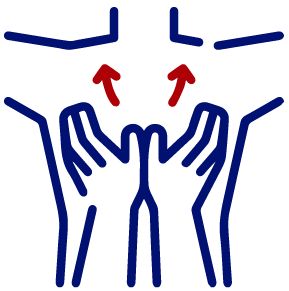
What Is Carpal Tunnel Syndrome?
Carpal Tunnel Syndrome occurs when the median nerve, which runs from the forearm into the hand, becomes compressed or squeezed at the wrist within the carpal tunnel.
While carpal tunnel syndrome is typically associated with activities that involve repetitive hand motions, such as typing or using hand tools, it can also be influenced by various factors like genetics, underlying health conditions, and even metabolic changes.
What are the Symptoms?
Carpal Tunnel Syndrome (CTS) is characterized by a variety of distressing symptoms that primarily affect the hand and wrist. Here are the symptoms:

Numbness and Tingling:
Individuals with CTS often experience numbness and tingling, particularly in the thumb, index, middle, and ring fingers. This sensation is often described as "pins and needles."

Hand Weakness
CTS can lead to weakness in the affected hand, making it challenging to grip objects or perform tasks that require fine motor skills.

Pain and Aching
Many people with CTS report pain or aching in the wrist, palm, and forearm. This discomfort may radiate up the arm.

Nighttime Symptoms
Symptoms of CTS frequently worsen at night. People may wake up with hand discomfort and have the urge to shake their hand for relief.

Difficulty with Coordination
Fine motor skills and coordination can be impaired, making tasks like buttoning a shirt or holding a pen more challenging. Inexplicably dropping items like coffee cups or pens/pencils can occur.
Causes and Risk Factors
Uncover the factors responsible for Carpal tunnel syndrome and the associated risks, offering insights for prevention and management. Understanding both the causes and risk factors is essential in diagnosing and effectively managing carpal tunnel syndrome.
What are the causes?
Carpal tunnel syndrome, a common condition affecting the wrist and hand, is primarily caused by the compression of the median nerve within the carpal tunnel. This compression can result from a combination of factors, including repetitive hand movements, wrist injuries, or underlying medical conditions.
- Compression: The primary cause is the compression of the median nerve as it passes through the carpal tunnel, which is a narrow passageway formed by wrist bones and the transverse carpal ligament.
- Swelling And Inflammation: Inflammation and swelling in the wrist due to injury or medical conditions can compress the nerve.
- Heredity: Some people may have a genetic predisposition to carpal tunnel syndrome.
- Work Environment: Prolonged exposure to repetitive motions and wrist strain in certain work environments can lead to the condition.
What are the risk factors?
Several factors can increase the likelihood of developing carpal tunnel syndrome, including gender, age, medical conditions like diabetes or rheumatoid arthritis, and activities involving continuous hand and wrist use. Genetics and wrist anatomy can also be predisposing factors.
- Repetitive Hand Use: Engaging in activities that involve repetitive hand and wrist movements, such as typing, assembly line work, or using vibrating tools, can increase the risk.
- Gender: Women are more commonly affected than men, possibly due to differences in carpal tunnel anatomy.
- Age: Carpal tunnel syndrome is more prevalent in middle-aged and older individuals.
- Medical Conditions: Certain conditions like diabetes, rheumatoid arthritis, and thyroid disorders, particularly hypothyroid, can increase susceptibility.
- Pregnancy: Hormonal changes during pregnancy can lead to swelling, potentially affecting the carpal tunnel.
- Obesity: Excess body weight can increase pressure on the median nerve.
- Wrist Anatomy: Anatomic variations in the carpal tunnel or wrist injuries can contribute to compression of the median nerve.
How Is The Carpal Tunnel Syndrome Diagnosed?
Diagnosing carpal tunnel syndrome involves a variety of methods and tests to identify its presence and severity. Here are the diagnostic procedures:
- Tinel’s Test: A healthcare provider lightly taps or presses on the median nerve at the wrist.
- Phalen’s Test: The patient is asked to flex their wrists by pressing the backs of their hands together and holding them in a bent position.
- Reverse Phalen’s Test: The test involves extending the wrists by pointing the fingers upward and holding this position.
A positive result in any of these tests, when combined with other clinical and diagnostic information, can help healthcare professionals in diagnosing CTS. However, a definitive diagnosis may require additional tests, such as nerve conduction studies or electromyography, X-ray, ultrasound, or MRI.

How Can We Treat Carpal Tunnel Syndrome
Discovering effective treatments for carpal tunnel syndrome is essential for individuals experiencing hand and wrist discomfort. Highlands Family Chiropractic offers various treatment options and strategies to alleviate symptoms, promote recovery, and improve the quality of life for those affected by this common condition.
Schedule Your Appointment Today
Contact us today to book a free 15-minute consultation with our Chiropractor in Highlands Ranch! We look forward to getting you on the path to optimal health and wellness.



